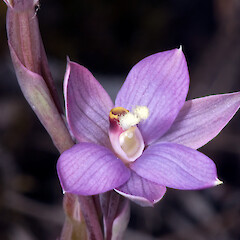Thelymitra hatchii
Common name
Hatch’s sun orchid
Synonyms
Thelymitra pachyphylla sensu Hatch
Family
Orchidaceae
Flora category
Vascular – Native
Endemic taxon
Yes
Endemic genus
No
Endemic family
No
Structural class
Orchids
NVS code
The National Vegetation Survey (NVS) Databank is a physical archive and electronic databank containing records of over 94,000 vegetation survey plots - including data from over 19,000 permanent plots. NVS maintains a standard set of species code abbreviations that correspond to standard scientific plant names from the Ngä Tipu o Aotearoa - New Zealand Plants database.
THEHAT
Chromosome number
2n = 66
Current conservation status
The conservation status of all known New Zealand vascular plant taxa at the rank of species and below were reassessed in 2017 using the New Zealand Threat Classification System (NZTCS) – more information about this can be found on the NZTCS website. This report includes a statistical summary and brief notes on changes since 2012 and replaces all previous NZTCS lists for vascular plants.
Please note, threat classifications are often suggested by authors when publications fall between NZTCS assessment periods – an interim threat classification status has not been assessed by the NZTCS panel.
- Conservation status of New Zealand indigenous vascular plants, 2017 . 2018. Peter J. de Lange, Jeremy R. Rolfe, John W. Barkla, Shannel P. Courtney, Paul D. Champion, Leon R. Perrie, Sarah M. Beadel, Kerry A. Ford, Ilse Breitwieser, Ines Schönberger, Rowan Hindmarsh-Walls, Peter B. Heenan and Kate Ladley. Department of Conservation. Source: NZTCS and licensed by DOC for reuse under the Creative Commons Attribution 4.0 International licence.
2017 | Not Threatened
Previous conservation statuses
2012 | Not Threatened
2009 | Not Threatened
2004 | Not Threatened
Distribution
Endemic. New Zealand: North Island, South Island, Stewart Island/Rakiura.
Habitat
Coastal to subalpine (up to 1300 m a.s.l.). Only coastal in southern part of range. Favouring clay banks, gravel, and open clay pans. Often in short scrub or fringing peat bogs and tarns. Preferring well lit places.
Detailed description
Terrestrial, tuberous, glabrous, spring to summer-green perennial herb, forming dense colonies of 4–20 plants arising through vegetative extension. Plants dark reddish-green, stiffly erect, at flower up to 600 mm tall. Leaf solitary, erect, very fleshy to almost fleshy-coriaceous, deeply channelled and prominently ribbed longitudinally, 100–300 × 7–15 mm, dark reddish-green to reddish brown, broadly lanceolate to linear-lanceolate, strongly v-shaped in cross section, distinctly keeled, base closely sheathing. Inflorescence a (3)–6–(8)-flowered raceme borne on a dark reddish-green to reddish brown stout, wiry stem. Bracts 1–2–(3), foliaceous, closely-sheathing, fleshy, of similar colour to stem and leaf. Flower 15–20 mm diameter, usually pale to deep mauve sometimes pink, without stripes or spots. Sepals, petals and labellum fairly similar; sepals acutely elliptic, petals elliptic. Column robust, up to 8 mm tall, erect, sometimes with a small basal triangular process, initially white soon grading to dark mauve, then dark reddish brown near apex; post anther lobe tall, overtopping anther at least at sides, erect, truncate, more or less coarsely laciniate or denticulate but not thickened, inrolled or cucullate, sometimes obliquely forming a deep cleft at back, often terminating in two sharply acute points, usually dark red toward apex, margin more or less yellow; column arms terete to plano-convex in cross section; cilia copious, prominent, usually yellow to pale yellow, more rarely white or pink, arising from sides, back and top of arm, standing erect and overtopping post-anther lobe.
Manaaki Whenua Online Interactive Key
Similar taxa
A distinctive species easily recognised by the dark reddish green foliage and stem; fleshy to fleshy-coriaceous, erect prominently keeled and v-shaped leaf; usually 6 flowered racemes; dark mauve flowers; dark reddish brown post anther lobe with a yellow, jagged margin, and column arms bearing copious, coarse, usually yellow cilia.
Flowering
November–March
Flower colours
Red/Pink, Violet/Purple
Fruiting
December–April
Propagation technique
Very easily grown in a sunny, well drained site. Often naturalises in gardens within urban areas abutting indigenous vegetation. Although easily cultivated, like all orchids it should not be removed from the wild.
Threats
Not Threatened. Abundant throughout its range.
Etymology
thelymitra: Woman’s hat
hatchii: After Hatch
Where To Buy
Not commercially available.
Attribution
Description adapted from Moore and Edgar (1970).
References and further reading
Moore LB, Edgar E. 1970. Flora of New Zealand, Volume II. Indigenous Tracheophyta: Monocotyledones except Gramineae. Government Printer, Wellington, NZ. 354 p.
Rolfe JR, de Lange PJ. 2010. Illustrated guide to New Zealand sun orchids, Thelymitra (Orchidaceae). Jeremy Rolfe, Wellington, NZ. 57 p.














